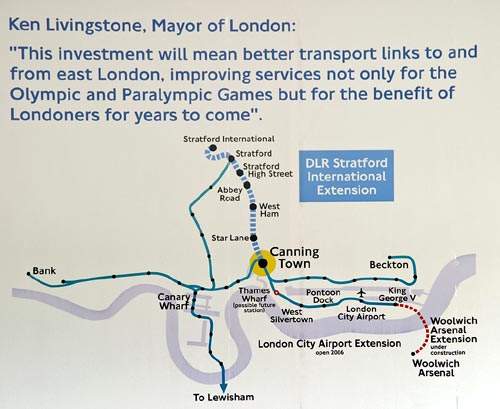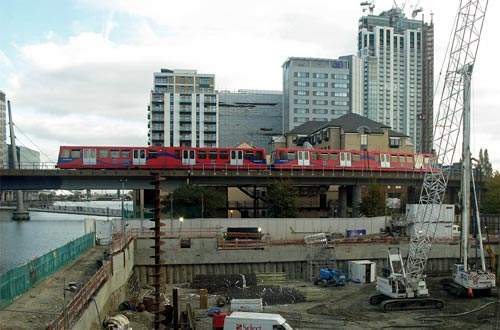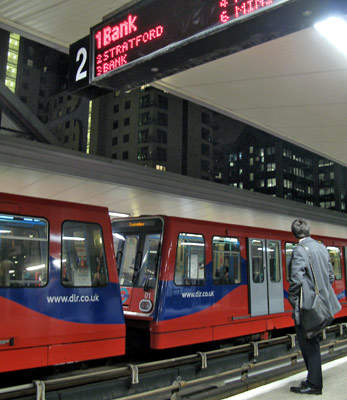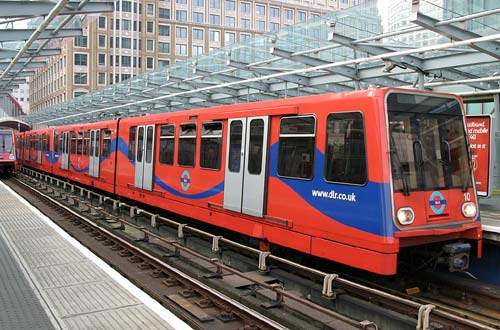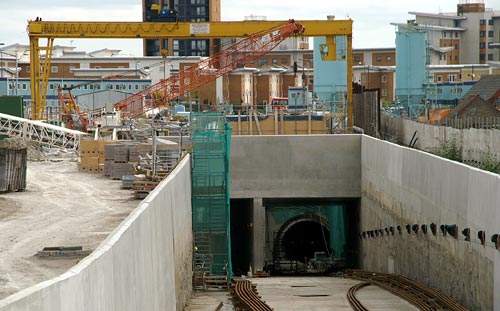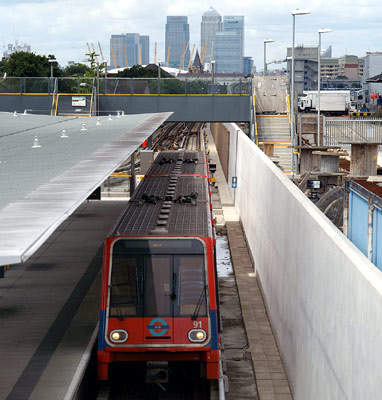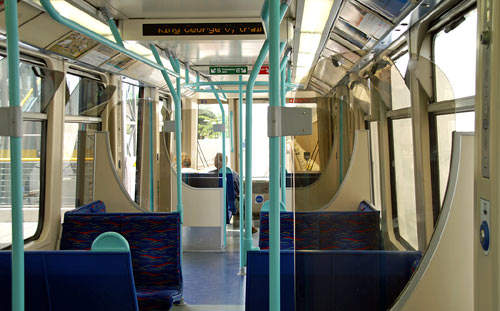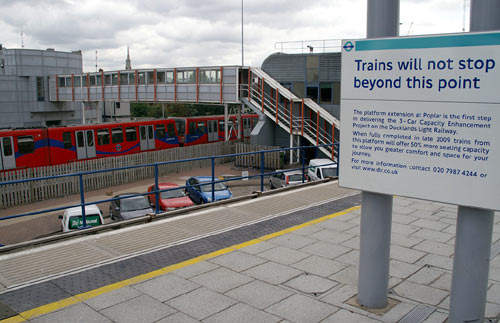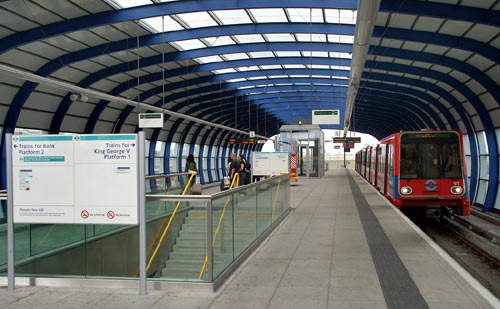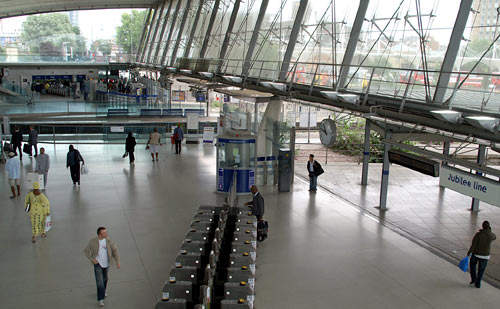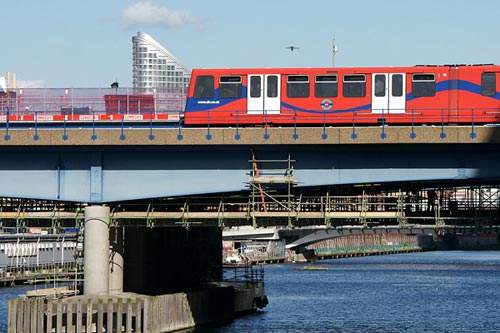Since opening in 1987, the Docklands Light Railway (DLR) has been central to the regeneration of east London. Now its significance is far greater than originally envisaged. The DLR started with three ‘arms’ linking termini at Stratford (north), Island Gardens (south) and Tower Gateway (west), the intersection being at Poplar.
It has been a key contributor to residential renewal and the creation of the Docklands business and finance district centred on the Canary Wharf complex, which doubled its workforce to 86,000 between 2001 and 2007. A role never foreseen was its forthcoming leading role as a key component in the UK’s staging of the 2012 Olympic Games.
The project
The original 13km, 13-station system cost £77m, but in the following 20 years, more than £1bn was spent on upgrades and extensions. New lines extended to Bank (July 1991), Beckton (March 1994), under the Thames to Greenwich and Lewis ham (November 1999) and as part of a project for a second Thames crossing, to London City Airport (December 2005), where, by 2008, it was handling around 50% of arriving and departing air passengers. A new line connecting King George V to Woolwich Arsenal was laid by January 2009.
The Olympic Games provided an opportunity to realign the area’s rail services.
The DLR has taken over the now abandoned North London Line section between Stratford and Canning Town from Network Rail. This gives direct access to the Olympic Park.
The DLR also served ExCel London, Greenwich Park and the Woolwich Royal Artillery Barracks in 2012 during the Olympic and Paralympic Games.
In May 2006, Transport for London (TfL) awarded a new £400m franchise to operate and maintain the DLR system to Serco Docklands (part of the Serco Group).
The new franchise brought targets, including at least 96% of trains running within three minutes of schedule, completion of the Woolwich Arsenal and Stratford International extensions, and the three-car upgrade to increase capacity between Bank and Lewisham, by early 2010. The platforms that were closed for upgrades for three-car operation were opened in February 2010.
The new three-car trains first ran on the Bank-Lewisham branch as the platform extensions had already being carried out.
In January 2010, the feasibility study associated with the extension of the DLR to Kidbrooke, Woolwich Arsenal and to Eltham was commissioned by the Eltham Regeneration Agency.
Infrastructure
As of January 2010, the DLR has 40 stations along a 31km-long line. The system has five branches in all directions.
The branches are to Lewisham in the south, Stratford in the north, and to Beckton and Woolwich Arsenal in the east. The western branch is to Central London and is split to serve Bank and Tower Gateway.
Because of the territory it traverses, a mix comprising existing intensive land use and the large bodies of water that were former East London docks, much of the DLR is on a viaduct, with many high-level stations. The original depot at Poplar, like the second at Beckton which has more available space, may be extended to handle more and longer trains.
In 2009, 70 million passenger journeys were recorded and 100 million in 2012. This was anticipated as a long-term trend and accordingly, a capacity increase programme was instituted. Platforms were lengthened and elevated structures were reinforced to take trains increased from two to three units.
Wholesale extensions of viaducts and curve realignment took place, with the key installations of North Quay Junction north of Canary Wharf and at Canning Town were remodelled. Lack of space due to adjacent curving track forced the reconstruction of South Quay station on a new, more easterly site. In May 2007, Taylor Woodrow was awarded a £200m contract for the construction works in connection with the train-lengthening project.
Commissioned in advance of the original system’s opening, a 1.6km (1-mile) underground line was built to Bank in London’s traditional financial centre. Now the DLR’s busiest weekday station, the most westerly DLR terminus was constructed beneath the existing London Underground platforms.
The initial City terminus, the elevated Tower Gateway, was retained to handle Beckton Line trains and was closed until 2009 for rebuilding under the capacity increase programme. Stations on the Lewisham line, partly in a bored tunnel and a 1.7km cut-and-cover section at near ground level, were subject to substantial reconstruction.
King George V in North Woolwich formed the temporary terminus of the branch from Canning Town opened in 2005 to serve London City Airport and, by early 2009, Woolwich Arsenal. Breakthrough on the second of the new twin-bore tunnels under the Thames was in July 2007.
The 1.8km Woolwich Line extension project that connects Woolwich on the south of the river with the King George V DLR station was opened before the scheduled date in January 2009.
Like Lewisham, Woolwich DLR is an interchange with mainline commuter trains, further reducing the need for travel via central London.
In July 2007, a £67m main construction contract was awarded to a Skanska-GrantRail joint venture for the £238m Canning Town-Stratford International line. The project includes rebuilding stations at Stratford, West Ham, Canning Town and Royal Victoria to DLR specification, notably for the step-free access that applies across the system. The line opened in September 2010.
New stations were built at Star Lane, Abbey Road, Stratford High Street and Stratford International, the last at the Olympic Park and providing connections with high-speed North Kent-London St Pancras services. A new station to serve a residential area, Langdon Park on the original Stratford line, was opened in 2008.
Automatic train control is managed from the central control room using a ’moving block‘ system which allows for closer headways than a conventional fixed block system. Replacing the original GEC installation and required to facilitate capacity growth, it is based on the Seltrac system, developed by Alcatel of Canada.
The train’s on-board computer continually communicates with the central computer, and if this signal is broken a train will be stopped until authorisation is given for it to continue. A train can still be driven manually, but if the driver over-speeds or leaves a station when the route is not set, emergency brakes are automatically applied.
In the event of a complete signalling failure, trains can run in emergency mode at 20km/h (12mph). The system allows for full bi-directional operation if required. DLR remains the UK’s only driverless automatically operated passenger railway.
In March 2010, Thales was contracted to provide SelTrac, a communications-based train control technology that accommodated the DLR’s upgrade from two to three-car services.
As part of Transport for London, DLR is covered by the Oyster card payment system and travelcards that cover multi-mode journeys, highly relevant with the system’s multiple interchanges.
Rolling stock
The DLR currently operates more than 149 light rail vehicles, of which 43 fixed-formation trains will be replaced under the Rolling Stock Replacement Programme. Deliveries are scheduled to conclude in June 2024.
The future
Growing complexity of the system and multiple destinations may call for routes to receive distinguishing designations as per TfL Underground. Given the runaway success of DLR, prospects for continuing expansion of the system appear good.

